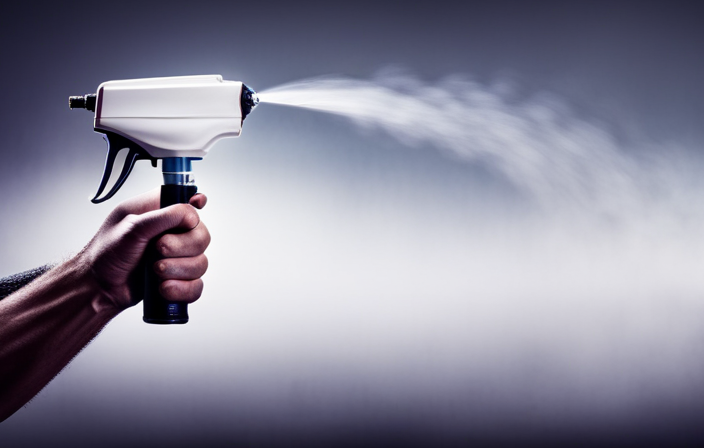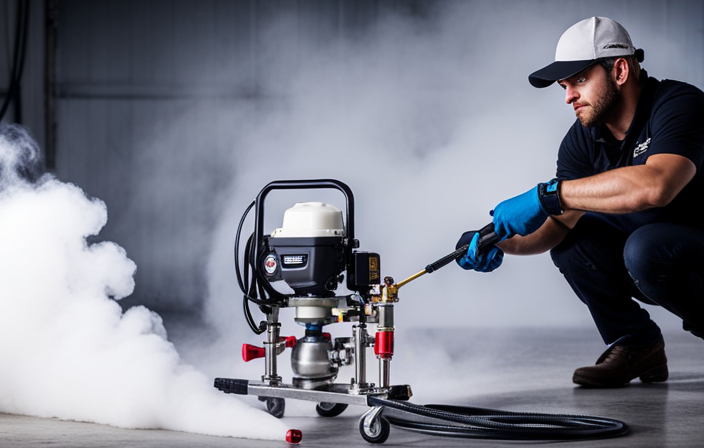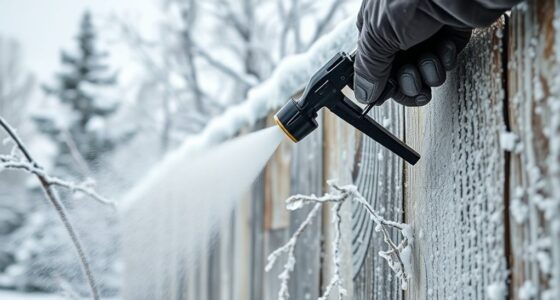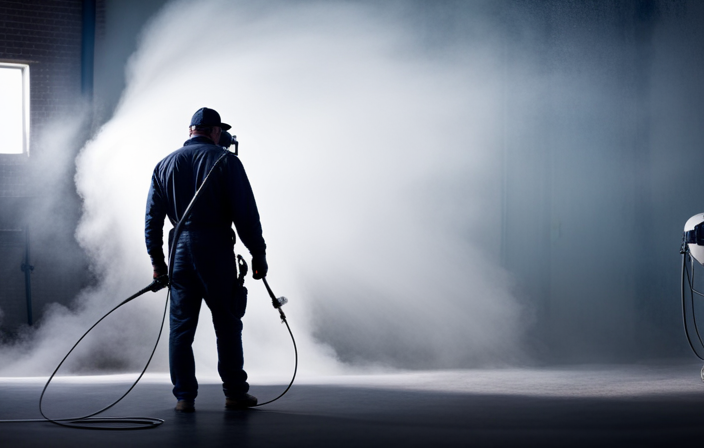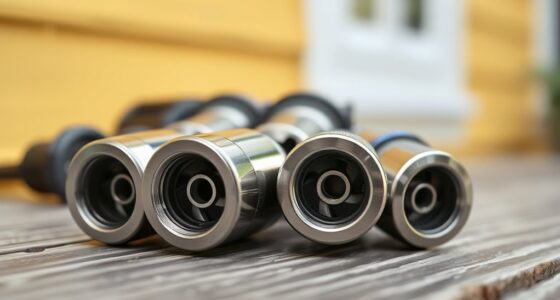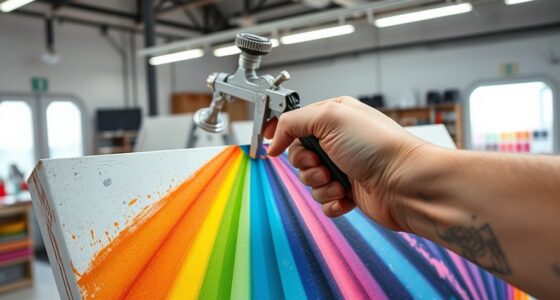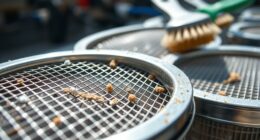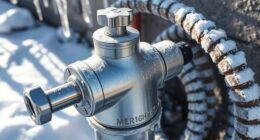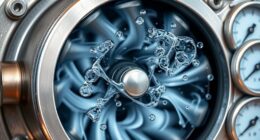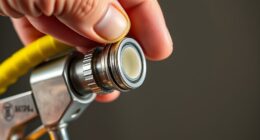Using an airless sprayer can cut your painting time in half. This powerful tool makes it easy to quickly paint large areas, giving your walls a professional finish. In this article, I will guide you through the steps of painting a wall with an airless sprayer.
First, you need to prepare the surface. Start by cleaning the wall thoroughly to remove any dirt or grease. Fill any holes or cracks with spackle and sand them smooth. Next, protect any areas you don’t want to paint, such as trim or windows, with painter’s tape and drop cloths.
Once the surface is prepped, it’s time to set up the sprayer. Start by assembling the sprayer according to the manufacturer’s instructions. Fill the sprayer with your chosen paint and adjust the pressure settings to achieve the desired spray pattern.
Before you start spraying, it’s important to practice your technique on a piece of cardboard or scrap material. This will help you get a feel for the sprayer and ensure you have the right settings.
When you’re ready to paint, start at one corner of the wall and work your way across in a smooth, even motion. Keep the sprayer about 12 inches away from the wall and overlap each pass slightly to ensure full coverage.
After you’ve finished painting, allow the wall to dry completely before applying a second coat if needed. Once the paint is dry, carefully remove the painter’s tape and clean the sprayer according to the manufacturer’s instructions.
By following these steps, you’ll be able to achieve a flawless paint job with an airless sprayer. Remember to always wear protective gear, such as goggles and a mask, and work in a well-ventilated area. Happy painting!
Key Takeaways
- Maintaining the correct distance from the wall surface ensures an even application of paint and reduces the chances of drips or splatter.
- Following techniques for a professional-looking finish can minimize mess and waste.
- Regularly cleaning and maintaining the sprayer is vital for a flawless finish and the sprayer’s longevity. This includes thoroughly cleaning the sprayer after each use and paying attention to the nozzle and filters for clogging.
- Regularly inspecting the sprayer for worn or damaged parts and replacing them as needed is important to avoid breakdowns during a painting project.
Prepare the Surface
Now it’s time to get your wall ready for a flawless paint job – you’ll want to start by prepping the surface.
Surface preparation is crucial to ensure the paint adheres properly and lasts longer. Begin by cleaning the wall thoroughly, removing any dirt, dust, or grease. Use a mild detergent and water solution for best results.
Next, inspect the surface for any cracks or holes and fill them with a suitable filler. Sand the wall to create a smooth and even surface.
Once the surface is clean and smooth, apply a primer using a roller or brush. Priming techniques vary depending on the type of surface, so make sure to follow the manufacturer’s instructions.
With the surface prepped and primed, it’s time to move on to the next section about choosing the right paint and equipment.
Choose the Right Paint and Equipment
When choosing paint for an airless sprayer, it’s important to select the appropriate type that is compatible with the sprayer and the surface you’re painting.
Additionally, gather all the necessary supplies such as paint filters, stir sticks, and safety equipment before starting the project.
Finally, set up and test the airless sprayer to ensure it is working properly before beginning the painting process.
Select the Appropriate Paint
To achieve the best results, it’s important to choose the right paint for your airless sprayer. When selecting the appropriate paint, there are two key factors to consider: choosing the right color and understanding different paint finishes.
Choosing the right color is essential for achieving the desired aesthetic for your wall. Consider the overall style and mood you want to create in the room. It’s also important to take into account the lighting conditions and the existing colors in the space.
Understanding different paint finishes is crucial as it determines the final look and durability of the painted surface. Common paint finishes include matte, eggshell, satin, semi-gloss, and high-gloss. Each finish has its own characteristics, such as the level of shine and ease of cleaning.
By carefully considering these factors, you can select the perfect paint that will work well with your airless sprayer and give your walls a professional and polished look. In the next section, we will discuss how to gather the necessary supplies for the painting process.
Gather the Necessary Supplies
Once you’ve carefully selected the perfect paint and considered the desired aesthetic, it’s time to gather all the necessary supplies for your upcoming painting project. Here are the four items you’ll need:
-
Airless sprayer: Make sure you have a reliable airless sprayer that suits your project’s size and requirements.
-
Paint: Acquire the chosen paint color scheme in the desired finish. Ensure it is compatible with an airless sprayer.
-
Safety equipment: Prioritize safety by wearing protective gear, including goggles, a respirator mask, and gloves. This will protect you from any potential hazards during the painting process.
-
Drop cloths and tape: Prepare the workspace by covering furniture, floors, and any other areas you want to protect from overspray. Secure the drop cloths with tape for added stability.
Once you have gathered these supplies, you’re ready to move on to the next section about setting up and testing the airless sprayer.
Set Up and Test the Airless Sprayer
Get ready to experience the thrill of setting up and testing your trusty airless sprayer, ensuring a smooth and flawless painting process.
Before starting, make sure you have all the necessary supplies, including the sprayer, paint, extension cords, and protective gear.
Begin by assembling the sprayer according to the manufacturer’s instructions, making sure all connections are secure.
Next, prime the sprayer by filling it with water and running it for a few minutes to remove any air bubbles.
If you encounter any issues during setup, such as leaks or clogs, consult the troubleshooting guide provided with your sprayer.
Common mistakes with airless sprayers include spraying too close to the wall or using too high of a pressure, resulting in uneven coverage or paint drips.
Once the sprayer is set up and tested, you can move on to the next section about practicing proper technique for a professional finish.
Practice Proper Technique
Mastering the art of airless spraying gives you the power to effortlessly glide the sprayer along the wall, leaving behind a flawless coat of paint. To improve efficiency and avoid common issues, here are some techniques to practice:
- Hold the sprayer perpendicular to the wall, maintaining a consistent distance of about 12 inches.
- Begin each stroke slightly before the starting point and continue slightly past the ending point to ensure even coverage.
- Move your whole arm, not just your wrist, to create smooth, overlapping passes.
- Maintain a steady, consistent speed to prevent drips or uneven application.
By practicing these techniques, you can ensure a professional finish and minimize the need for touch-ups.
Now that you’ve mastered the proper technique, let’s move on to the next section and start painting.
Start Painting
Now that you have honed your skills, it’s time to unleash your artistic touch and bring your vision to life. When starting to paint with an airless sprayer, it’s crucial to employ proper painting techniques to ensure a smooth and professional finish. Here are some helpful tips to guide you through the process and troubleshoot any issues that may arise.
| Painting Techniques | Troubleshooting Tips |
|---|---|
| Maintain a consistent distance from the wall while spraying. | If the paint is uneven or streaky, adjust the sprayer’s pressure settings. |
| Move your arm smoothly and steadily to avoid uneven coverage. | If the paint is dripping or splattering, check the nozzle for clogs and clean if necessary. |
| Overlap each pass by 50% to prevent missed spots. | If the paint is coming out in a misty spray, check the sprayer’s filter and clean or replace as needed. |
By mastering these techniques and troubleshooting tips, you can achieve professional-looking results. In the next section, we will discuss how to effectively manage overspray and drips without compromising your project.
Manage Overspray and Drips
To effectively manage overspray and drips, it’s important to be mindful of your surroundings and have careful control over the direction and flow of your artistic creation. Here are some key strategies to avoid paint splatter and control the spray pattern:
-
Prepare the area: Cover nearby furniture, floors, and objects with drop cloths or plastic sheets to protect them from accidental overspray.
-
Adjust the spray pattern: Use the nozzle adjustment feature on your airless sprayer to change the width and shape of the spray pattern. This allows you to control the coverage and minimize overspray.
-
Maintain the correct distance: Hold the sprayer nozzle at a consistent distance from the wall surface. This helps ensure an even application of paint and reduces the chances of drips or splatter.
By following these techniques, you can achieve a professional-looking finish while minimizing mess and waste.
In the next section, we will discuss how to clean and maintain the sprayer to prolong its lifespan.
Clean and Maintain the Sprayer
To keep your equipment running smoothly and ensure a flawless finish, it’s vital that you regularly clean and maintain your sprayer.
Sprayer maintenance is crucial for its longevity and performance. After each use, make sure to clean the sprayer thoroughly. Flush out any leftover paint or debris by running clean water or solvent through the system.
Pay close attention to the nozzle and filters, as they are prone to clogging. Remove any obstructions or buildup to prevent issues with the spray pattern.
Additionally, regularly inspect the sprayer for any worn or damaged parts. Replace them as needed to avoid any potential breakdowns during your painting project.
By following these maintenance steps and troubleshooting tips, you can ensure that your sprayer operates at its best and delivers impeccable results every time.
Frequently Asked Questions
How do I ensure that my walls are properly prepared before using an airless sprayer?
Before using an airless sprayer, I make sure my walls are properly prepared. It’s like laying a strong foundation for a building; it ensures smooth, even paint application and a flawless finish. I focus on wall cleaning, repairing imperfections, and using proper masking techniques.
What are the key factors to consider when selecting the right paint and equipment for airless spraying?
When selecting paint colors for airless spraying, consider factors such as viscosity, coverage, and drying time. The benefits of using an airless sprayer include faster application, smoother finish, and reduced overspray.
Can you provide some tips on how to practice proper technique when using an airless sprayer?
Proper airless sprayer technique is crucial for effective use. Here are some tips: maintain a consistent spraying distance, use smooth and overlapping strokes, adjust pressure and nozzle size accordingly, and practice with different materials and surfaces.
What are some common mistakes to avoid when starting to paint with an airless sprayer?
Common mistakes when starting to paint with an airless sprayer include not properly preparing the surface, using the wrong nozzle size, spraying too quickly or too close, and not cleaning the sprayer thoroughly. Here are some troubleshooting tips to avoid these errors.
Are there any specific techniques or tools to help manage overspray and drips while using an airless sprayer?
To manage overspray and prevent drips when using an airless sprayer, there are a few techniques and tools you can use. Adjusting the pressure, using a spray shield, and practicing proper spraying techniques can help minimize these issues.
Conclusion
In conclusion, painting a wall with an airless sprayer can be a game-changer in terms of efficiency and quality.
To achieve professional-looking results, it is important to follow a few key steps.
First, prepare the surface properly by cleaning it thoroughly and repairing any cracks or imperfections. This will ensure that the paint adheres well and provides a smooth finish.
Next, select the appropriate paint and equipment for the job. Consider factors such as the type of surface, the desired finish, and the size of the project.
Once you have everything ready, it’s time to master the technique. Hold the sprayer about 12-18 inches away from the wall and move it in a steady, overlapping motion. Start from the top and work your way down, making sure to maintain a consistent distance from the surface.
Be mindful of overspray by using drop cloths and masking off areas that you don’t want to paint. This will help prevent any accidental splatters or stains.
Finally, don’t forget about maintenance. Clean the sprayer thoroughly after each use to prevent clogs and ensure its longevity.
With careful attention to these steps, painting a wall with an airless sprayer can be a rewarding and efficient process. Just like an artist wielding a brush, the sprayer becomes an extension of your hand, effortlessly transforming the wall into a canvas of color.
